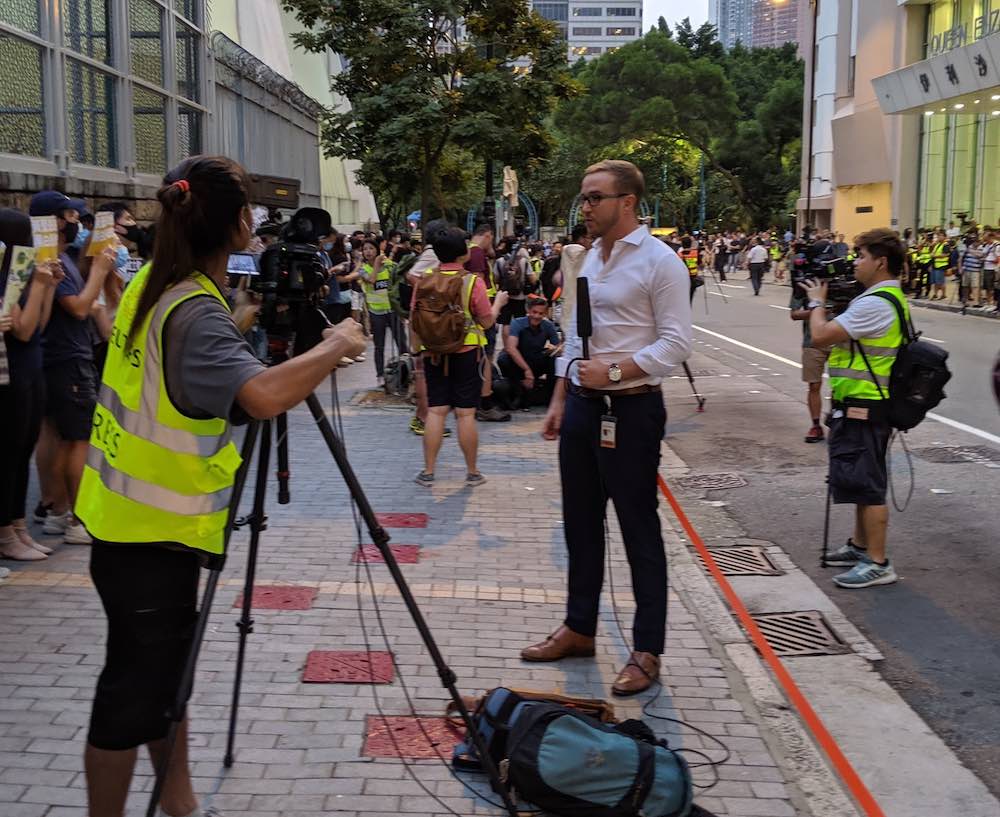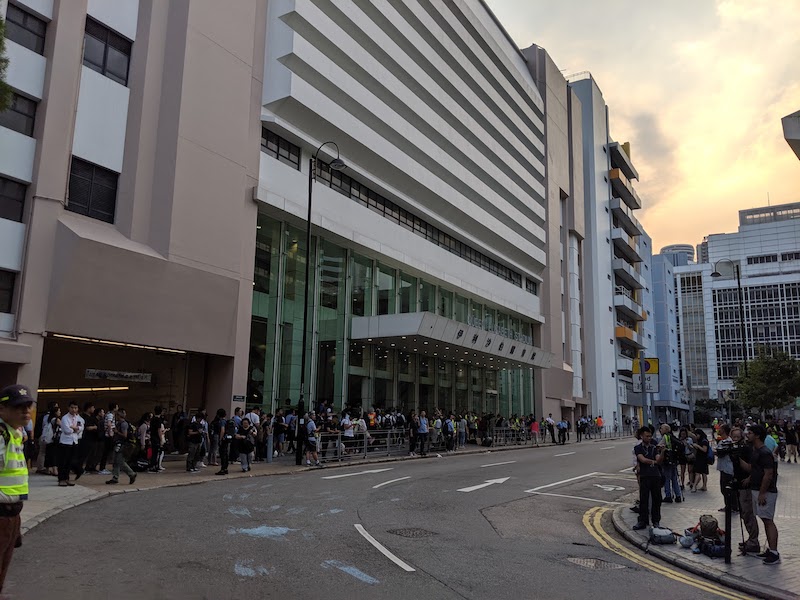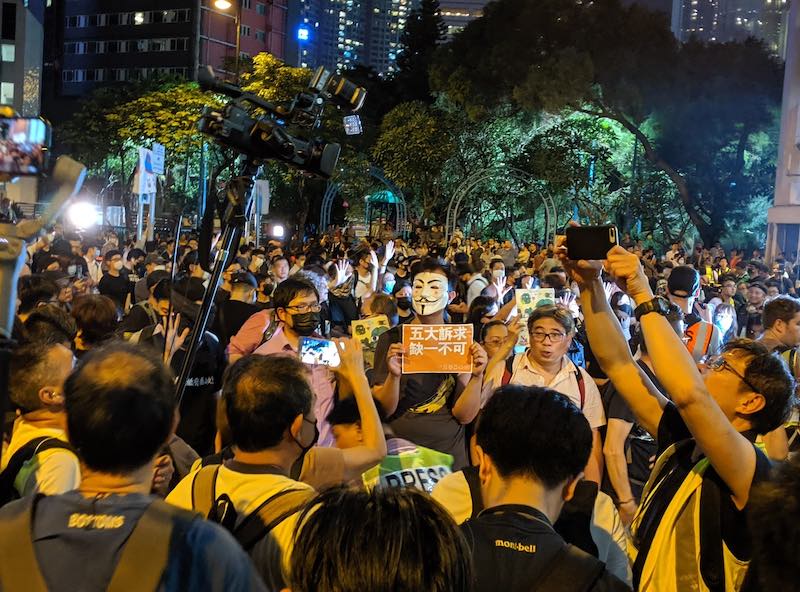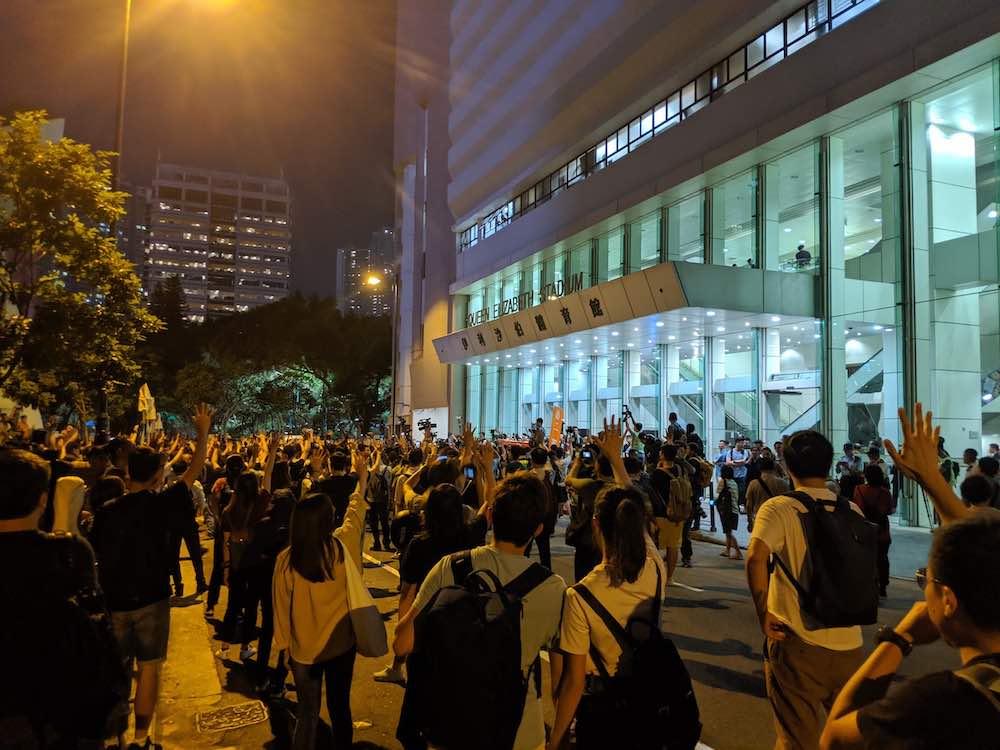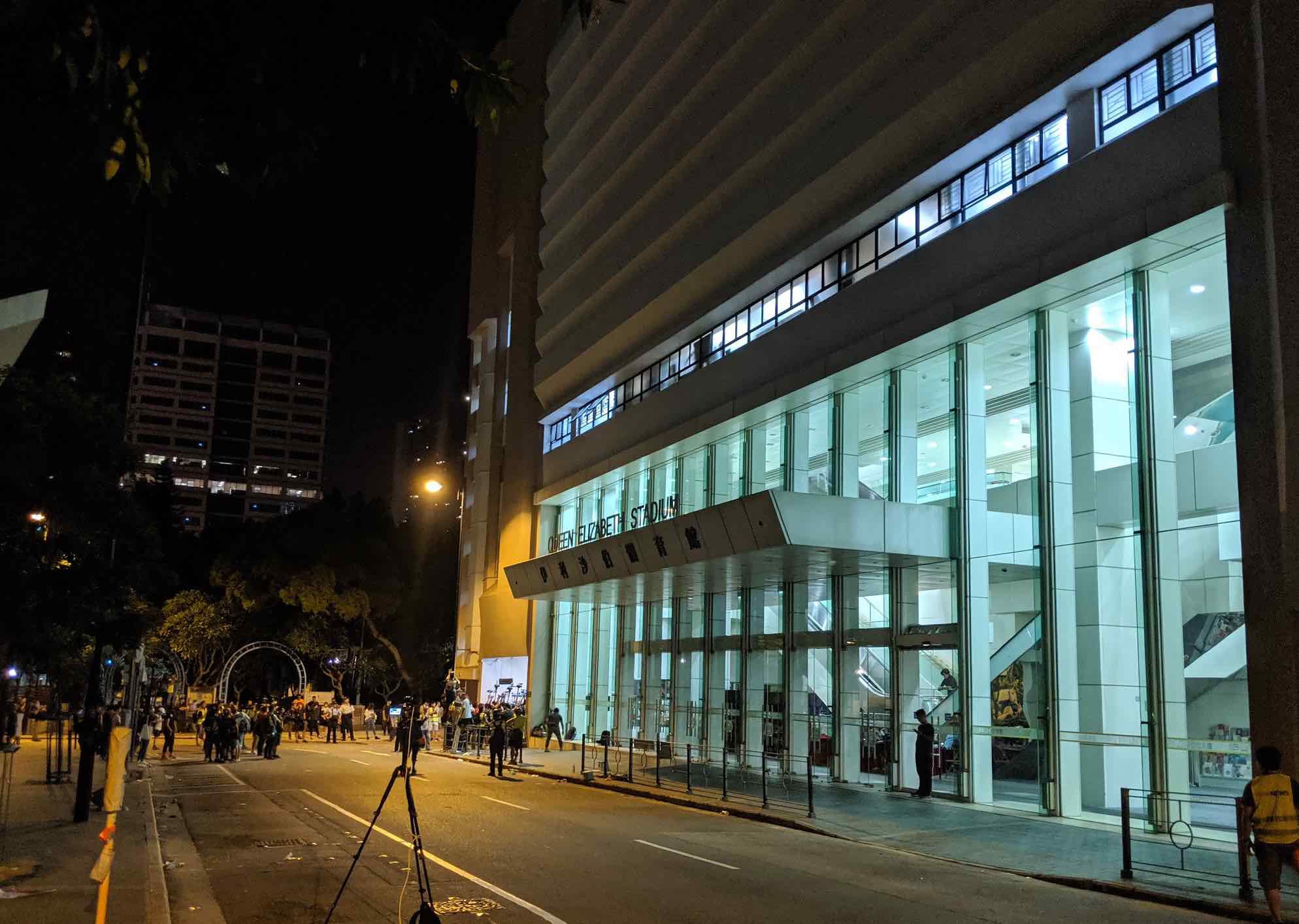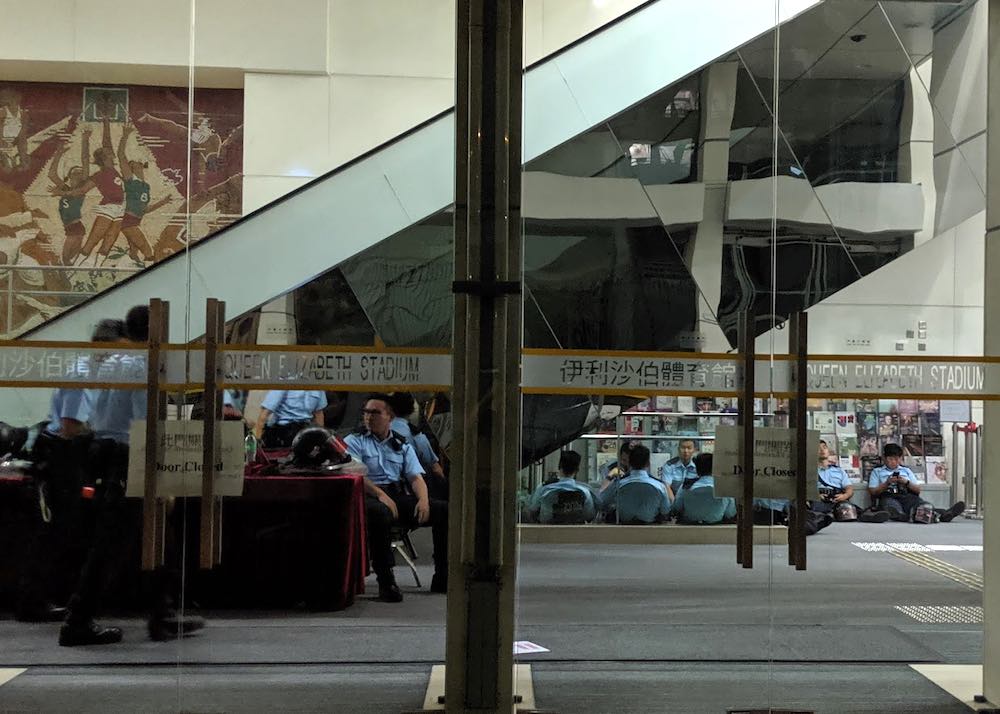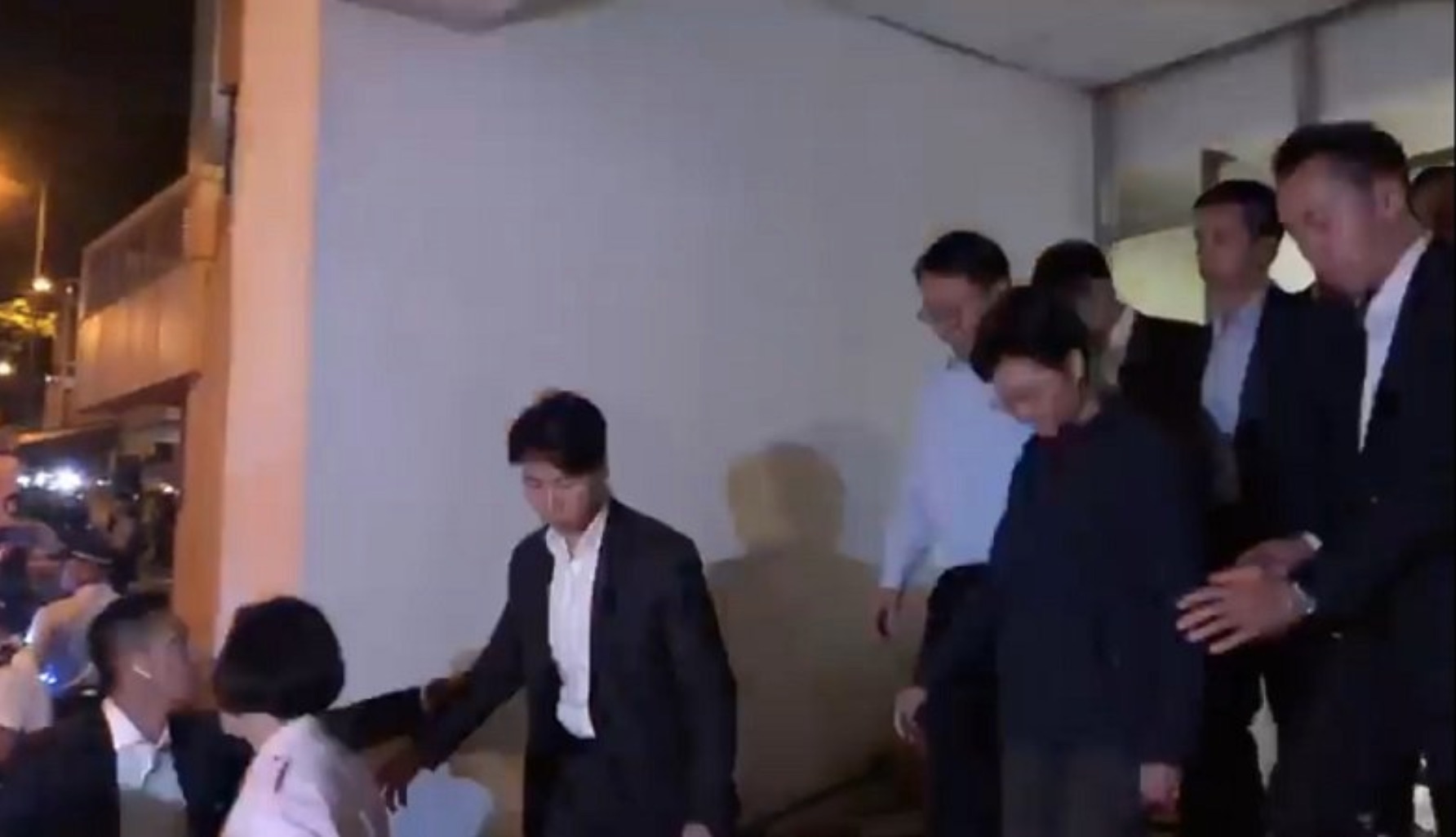On September 26, 2019, Hong Kong Chief Executive Carrie Lam held her first listening session after seventeen weeks of protest. Her government, which had spent the summer nearly incommunicado, had settled on these encounters as a way to heal social divisions and identify the mysterious goals of a movement whose five demands, now that school was back in session, could be recited by any schoolchild.
Writing in a New York Times op-ed titled “Hong Kong, I Am Listening” on the eve of the event, Lam promised that this encounter with the public would be “the first of many community dialogues to air the public’s grievances and identify the issues this society faces.” She reminded readers of her 2017 campaign slogan: ‘We Connect.’
Hong Kongers who wanted to open their hearts to the government were invited to enter a random drawing online. Out of some 20,000 people who applied, 150 were chosen by lot to attend the event, at Queen Elizabeth Stadium (despite the name, a very regular looking building in a residential pocket of Wan Chai). The rest of the city tuned in to watch the session on TV.
Police cordoned off the venue with their usual light touch, blocking a dozen streets to traffic and giving a normally busy neighborhood the feeling of a ghost town. The large municipal pool was closed. An LED notice board on the side of Ammar Mosque blinked its friendly greetings to no one. Protesters who filtered into the area lined up opposite the building, while the usual scrum of press milled around, looking for something dramatic to film.
A subversive element had placed a chair out front, with a note that it was reserved for Carrie Lam. No one sat in it. Two hours before the session started, the street was packed with people hoping for a glimpse of their listening leader.
Police were everywhere. Blue-jacketed media liaisons (meant to be the kindler, gentler face of the Hong Kong police force) admonished everyone to stay on the sidewalk. Every so often a red taxi parted the crowd to disgorge a lucky citizen, like the winner of a Willy Wonka golden ticket, who would be allowed inside to ask, for the first time in 17 weeks, just what the hell the Hong Kong Chief Executive thought she was doing.
Carrie Lam is a Theresa May-like figure who seems to thrive on a performative stoicism, standing firm in the face of a self-inflicted crisis that a more capable politician would simply wiggle out of. She is a tragic figure in the same way that a pilot who points the nose of the aircraft at a mountain and refuses to listen to the passengers screaming for her to turn is a tragic figure. You puzzle over her motives while also wishing that someone, anyone, would throw her out of the plane.
But while May was at least an elected politician, Carrie Lam is an administrator down to her bones, a career civil servant who was elevated to power in 2017 and sees her role as a protector of order. Her litany throughout the crisis has been that Hong Kongers who are not the police must respect the rule of law, even when that law (as would happen a week after this event) is imposed by emergency decree. A former head prefect at her Catholic school, she has all the empathy of a supervisor at the department of motor vehicles explaining that your car will be compressed into a cube because of overdue parking fines.
Lam seems to have an innate aversion to the mob, the rabble, the people who in luckier places we would call voters. After a quarter of the city’s population marched in July, she called the protesters “a small minority of people” who “had no stake in their society.”
In November, she would refer to protesters more chillingly as ‘enemies of the people’, language that carries murderous connotations in China.
Lam’s preference is always for closed-door meetings, where she can speak to business leaders and other chosen audiences about how limited her options are, and how she can do nothing without permission from the center. In one such session that was surreptitiously recorded and leaked in August, Lam said she would not allow herself self-pity before reciting a litany of complaints. She wanted nothing more than to apologize and resign, she said, but Beijing wouldn’t let her. On policy matters, her hands were tied. Black-clad protesters had made her life a hell. She couldn’t even visit the hair salon in Hong Kong without fear of getting swarmed.
Tonight, though, she would be facing the public. Her hair looked amazing.
When the crisis in Hong Kong began, it was universally believed that Carrie Lam was executing a subtle plan dictated from Beijing. The attempt to rush an extradition law through the Legislative Council looked like a move in China’s long geopolitical chess game to erase constitutional protections in Hong Kong without spooking international finance.
So it was a shock to everyone when it emerged later in the crisis that the extradition law had been Carrie Lam’s own initiative. Rather than playing six-dimensional chess, it appeared that Beijing had accidentally appointed the most inflexible politician in China to head the Hong Kong S.A.R., and was now watching the ensuing disaster unfold as helplessly as everybody else.
Lam had plunged the financial capital of China into a crisis that required finesse, tact, and strategic retreat, and was attempting to solve it with tear gas and truncheons. Her bumbling radicalized a famously apolitical city, destroyed the Hong Kong police force, and welded an amorphous and diverse set of interests into something like a national identity.
A movement that had started with Christian hymns and a Les Miserables song now had its own national anthem, complete with a professionally produced video in which a symphony orchestra dressed in gas masks plays amidst clouds of tear gas. By September, the whole city had learned it by heart, and performed it at shopping malls, sporting events, schools, and spontaneously on the street. Tonight, if she cared to, she could hear it being sung outside her listening event.
Like a player scoring an own goal through an otherwise impenetrable defense, Lam had achieved by accident what no Chief Executive could have done through years of toil. She had forged Hong Kong into a nation. She was the accidental mother of her country.
Xinqi Su is a dynamo of Hong Kong journalism who finds a way to livetweet every significant protest event. True to form, on this night she was translating and posting audience questions almost in real time. Groups of six questioners were chosen by lot out of the audience. Each person got three minutes to speak. After everyone in a group had spoken, Lam (flanked by silent members of her cabinet) made her reply.
Many of the questioners wore masks. Perhaps they were mindful of what had happened the last time Lam held such a televised debate. All five student leaders who confronted her on television in the summer of 2014 were later arrested; three of them went to prison.
Possibly the audience was thinking of more recent events, like the August 29 attack in broad daylight on Jimmy Sham, head of the Civil Human Rights Front (Sham would be viciously beaten again on October 16), or a similar attack on legislator Roy Kwong, assaulted just two nights before the listening event.
(These fears were not misplaced. A second legislator, Stanley Ho, would be beaten three days after this event, on September 29, while several prominent opposition figures would be arrested on September 30.)
Two of the questioners stressed in their remarks that they were not suicidal, reflecting a pervasive belief among young people that a spate of police murders had been disguised as suicides. While not supported by evidence, these rumors, along with stories of deaths and disappearances at the Prince Edward MTR station, were deeply woven into the fabric of fear in Hong Kong, and no one in government had the moral authority or legitimacy to refute them.
Not surprisingly, this toxic level of mistrust was the central theme of the night. Person after person got up and asked Lam essentially the same thing—why did she refuse to set up an independent public inquiry into police brutality? Why had no one resigned or faced any disciplinary action after a summer of escalating abuses of power?
The sole questioner who used her time to praise the police and call for an investigation into the demonstrators was soon outed by internet sleuths as an off-duty cop. The message was not flattering: the government was so incompetent they couldn’t even rig their own listening event.
Lam gave each of these questioners the same answer as ever, which was no answer at all. There’s already an organization for handling police complaints, she said, shall we wait for them to finish their work?
No one on either side of the conflict , then or now, has a satisfactory theory of why Carrie Lam won’t form an independent inquiry into police violence, the demand that is the emotional core of the protests.
It’s obvious why the fifth demand, universal suffrage, poses a serious threat to China.
But why couldn’t there be an independent investigation into the police? Surely a career bureaucrat like Lam could think of a thousand ways to set up a commission that wouldn’t have teeth? It could study the situation for years, immunize everyone against prosecution, and eventually emit a report criticizing both sides for the excesses of the summer. If done with finesse, such a commission might even split the protest movement, the government’s cherished dream.
In other word, it was a bureaucratic lay-up. And yet Lam wouldn’t budge.
This was still September, before the police had shot a high schooler in the chest, before Lam’s government invoked emergency law for the first time since 1967, before the siege of the universities, before anyone had died at a protest. Total arrests on the eve of her listening session were 1,500 (today they are over 5,500). But already the police were the greatest threat to public safety in Hong Kong.
An emotional point of no return had come on July 21, when triad thugs burst into the Yuen Long MTR station and beat passengers at random. Two police officers who were witnesses to the scene had simply walked away. Nearby police stations pulled down their steel shutters as residents banged on them pleading for help. A police commander later revealed that five triads had spent weeks planning the event, either undetected by the police, or with their tacit connivance.
The Yuen Long attack was too much even for some Hong Kong cops to stomach. The triads were the enemy, not an auxiliary force to call in when a crowd needed to be roughed up without directly implicating the police. To the public, Yuen Long was the ultimate proof that the police were irredeemable.
When riot cops burst into Prince Edward station six weeks later and beat up passengers in an echo of the July attack, it simply confirmed the police and triads were interchangeable. 721 and 831 became numerical shorthand for the lawlessness and perfidy of the police.
Lam insisted at this listening event (and continues to insist today) that police should only investigate itself through the Independent Police Complaints Council, a sort of administrative oversight board for internal investigations. The IPCC lacks subpoena power and cannot protect witnesses against police retaliation.
It also can’t take complaints directly from citizens. Instead, they are supposed to report it first to a local police station, through a group ominously called CAPO (Complaints Against Police Office). The requirement that abuse be reported to the perpetrators puts people in absurd, awful situations—if you are assaulted at a police station, for example, the correct procedure is to turn around and go back inside to file your complaint.
When police officers involved in misconduct took to removing their badge numbers, which was the universal behavior by August, citizens had no redress at all. The police simply lied, even in the face of incontrovertible evidence. In one famous incident, they insisted that film showing a man in a yellow shirt being beaten by police in an alley showed only a “yellow object” who could not definitively be called a human being.
This abusive behavior at the hands of the Hong Kong police force was no longer an aberration, but policy. The police had adopted a counterinsurgency strategy that assumed the existence of a hard core of several hundred frontline demonstrators. The sooner those troublemakers could be arrested, the police logic went, the quicker the protests would come to an end. All other considerations went out the window.
The transformation of police into an occupying army left ordinary Hong Kongers without redress. The IPCC had been set up to catch the occasional corrupt cop, not to second-guess policy decisions made at the highest levels. Its members were all appointed by the Chief Executive.
A clear example of how broken the system was came just a day after this listening session, when a 22 year old woman was taken into in the Tsuen Wan police station, in the New Territories, and allegedly raped by four masked men. On October 22, she filed a complaint with the Complaints against Police Office. A few days later, the police obtained a search warrant for her medical records, including closed-circuit footage from her doctor’s clinic.
While the search warrant was finally quashed in court on November 28, the message it sent to potential accusers still hangs over Hong Kong: if you accuse the police, your life will be an open book, with the most private details leaked by the investigators you were forced to turn to in your search for justice.
And so it was that by early September, half of Hong Kongers said that on a scale of zero to ten, they had zero trust in police. Stories continued to surface about physical and sexual abuse in custody. Wilder rumors circulated, too, with no way to gainsay them. Carrie Lam’s approval rating dropped below twenty percent, a record for a Hong Kong chief executive. Seventy four percent said that if there were an election, they would vote against her.
But of course, there wasn’t going to be an election. That was the whole problem.
Once the listening event was over, Carrie Lam faced a new challenge—how to get out of the building. It was 10 PM and there were perhaps a couple of hundred protesters outside. Word had filtered out that Lam had told police not to disperse the crowd—even her awful political instincts could tell her not to tear gas her own listening event. I had gone home for the night, but this situation seemed too ripe to miss, so I retraced my steps through the now empty streets of Wan Chai.
It was eleven by the time I reached the stadium. The listening event had been over for an hour, and the neighborhood was quiet. Around Queen Elizabeth Stadium, the ranks of the protesters had thinned. Most of the chanting was being done from a garden wall by an elderly uncle who was working his way through a six pack.
The police officers occupying the glass-walled lobby looked tired. Sometime towards midnight, their commander gave them permission to sit along the base of the wall, and within minutes several were sleeping. A long weekend of oppression and police violence lay ahead of them, as the city braced for the National Day celebrations on October 1. Tonight’s event was supposed to have been an easy night off. Instead, Hong Kong’s finest were in for another cold dinner and cheerless homecoming.
Hong Kongers are savage when it comes to taunting the cops. They find the most resourceful ways to get under the police’s armor and sting them in the heart. At a recent rally, somebody had yelled “while you’re here, your wife’s at home banging a frontliner!” Tonight, the policeman’s wife and the frontliner would have time to cuddle. No one was coming home anytime soon.
A few minutes past midnight, the drunk uncle finished his last beer and zigzagged away. The police were sound asleep. The protesters sat and waited, while the press corps continued their stakeout of the parking garage. Every once in a while, the journalists would spook themselves into a burst of activity, like chickens do when the fox is near. But it was always a false alarm, and they retreated back into their phones.
By one o’clock, only a dozen or so protesters remained, far outnumbered by the press. I saw the blinds part in a window above the parking garage, and two eyes peer out through the gap. A small voice from the street called out in English:
“Carrie Lam, come out!”
But Carrie Lam stayed in.
Around 1:30, a senior policeman woke up his colleagues in the lobby. They shuffled off somewhere, and soon after, a squad of them in riot gear burst out a side door into the alley, flashing strobe lights and making a racket. Two cameramen jogged over to film them and got yelled at. The police unit trotted off into the night.
More waiting. Then, finally, an unmistakable burst of activity in the parking garage. SUV doors opened and engines rumbled to life. The reporters rushed forward to film, forming a semicircle in front of the parking ramp. A few hoarse voices, all that was left of the protesters, began to chant. I counted no more than ten. The SUVs roared up the ramp, then turned off their engines.
It was a feint. The handsome black SUVs had been sent to deke us out while Carrie Lam was hustled out the door on the opposite side of the building, where a camera captured her escape. She looked serene as ever, still smiling, still poised, surrounded by the police who from now on would be her only point of contact with the public. They led her to a waiting car, protecting her from a threat that existed only in her imagination.
And that was the last time the government held a listening session in Hong Kong.
« A Week With No Tear Gas
